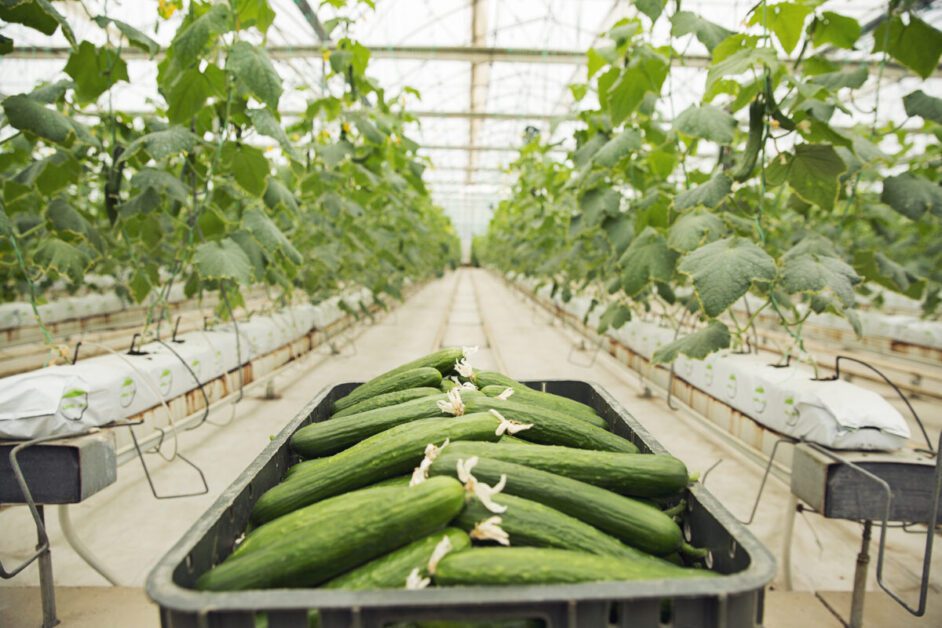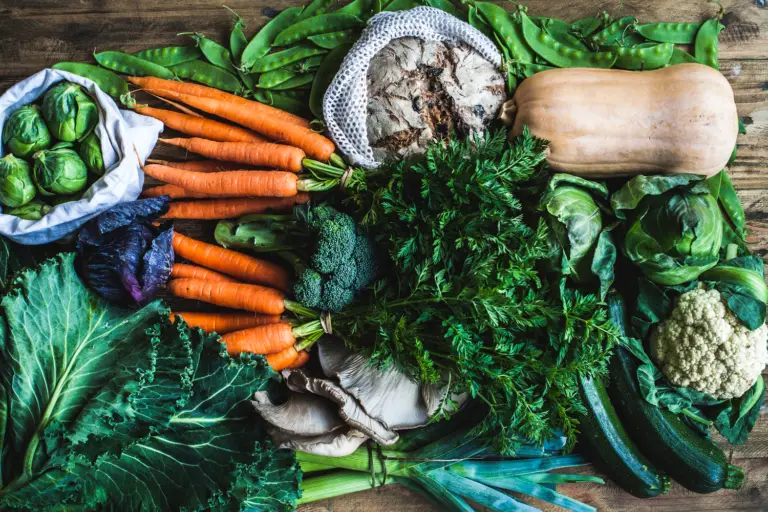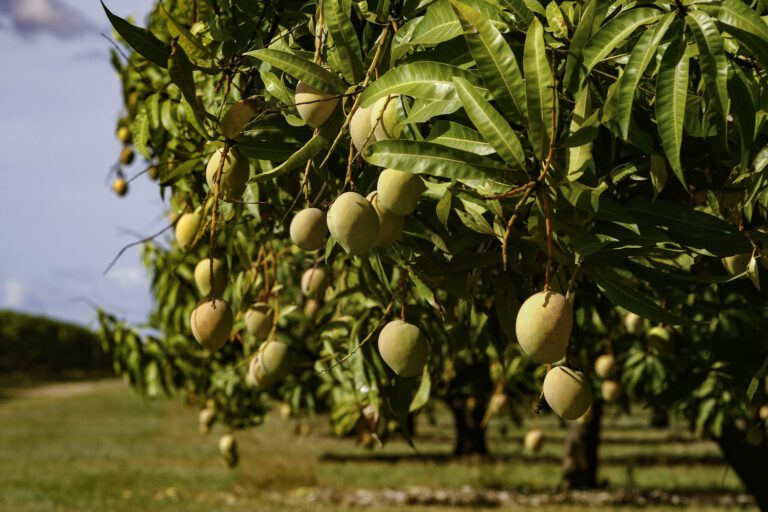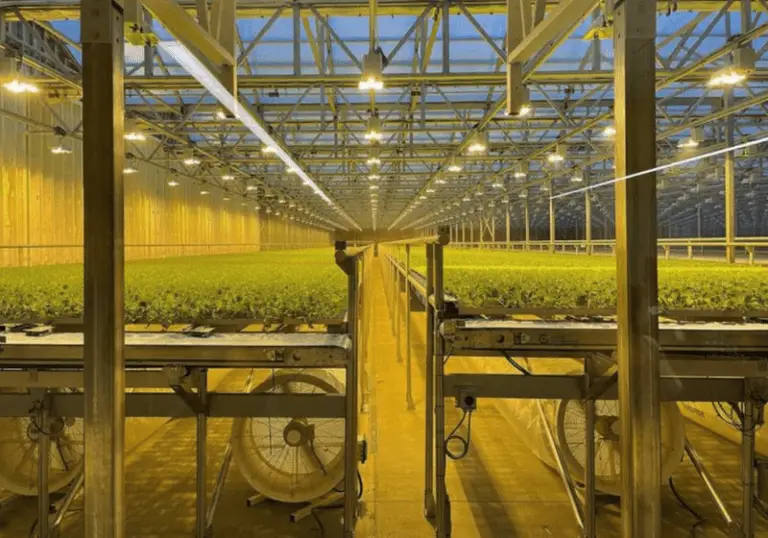Grow Cucumbers Hydroponically: Discover 5 Outstanding Varieties
Table of Contents
Hydroponic Cultivation of Cucumbers: An Overview
Introduction:
Cucumbers are a popular vegetable loved by many gardening enthusiasts for their refreshing taste and versatility in culinary uses. Traditionally, cucumbers have been grown in soil-based systems, but in recent years, hydroponic cultivation has gained significant attention. Hydroponic cultivation of cucumbers involves growing them in a nutrient-rich solution, without the use of soil. This innovative approach has numerous advantages, including increased yield potential, improved resource efficiency, and reduced susceptibility to soil-borne pests and diseases. In this article, we will explore the world of hydroponic cultivation of cucumbers, providing an overview of the techniques, benefits, challenges, and best practices associated with this exciting method of growing cucumbers.
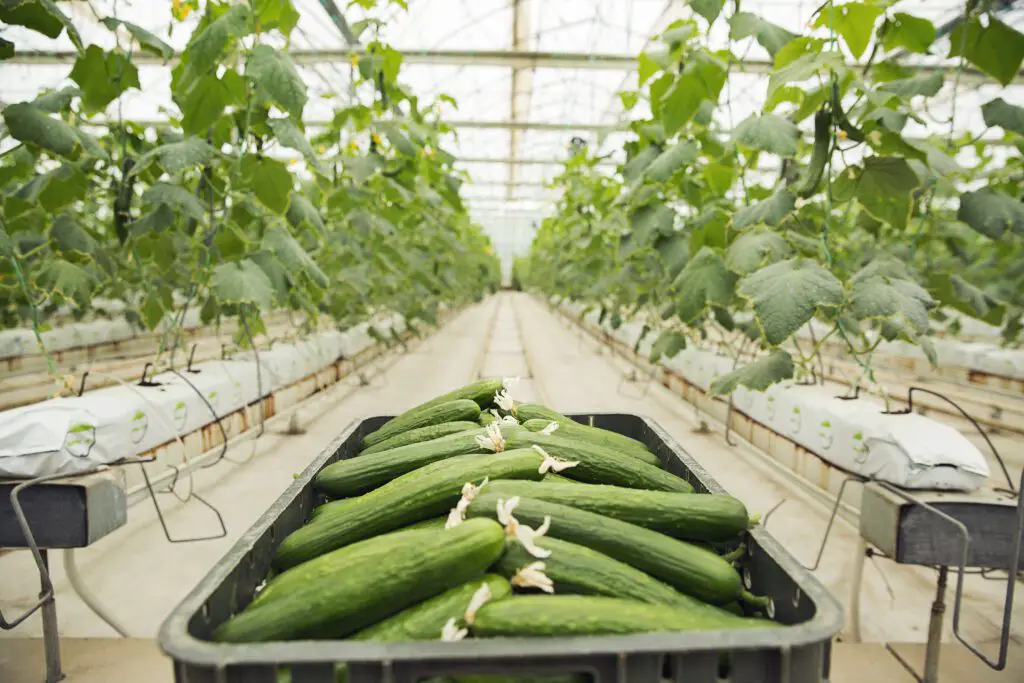
Advantages of Hydroponic Cultivation:
Hydroponic cultivation offers a range of benefits that have made it increasingly popular among cucumber growers. Firstly, by eliminating the need for soil, hydroponic systems allow for precise control over the growing environment, including nutrient availability, pH levels, and water content. This level of control enables growers to optimize plant growth, resulting in faster maturation, increased yield potential, and improved quality of cucumbers. Additionally, hydroponic systems require less water compared to traditional soil-based cultivation methods, making them a more sustainable option. Furthermore, as hydroponic systems are typically indoor or greenhouse-based, they provide year-round cultivation opportunities, ensuring a steady supply of fresh cucumbers even in regions with limited outdoor growing seasons.
Choosing the Right Cucumber Varieties for Hydroponic Systems
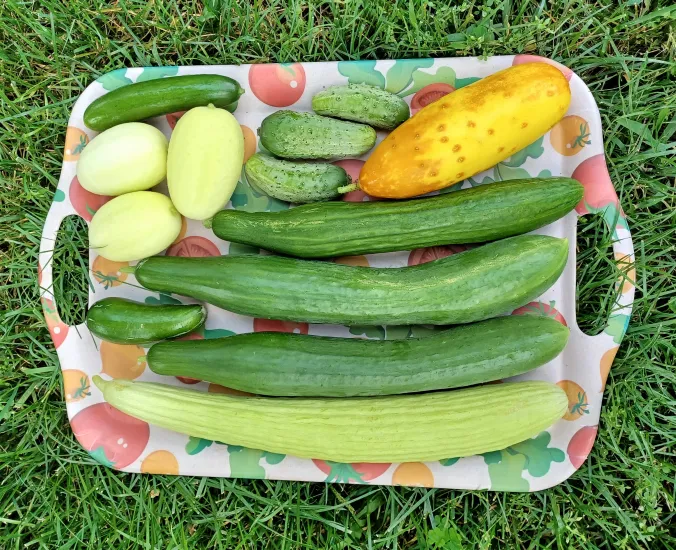
There are several important factors to consider when choosing cucumber varieties for hydroponic systems. Firstly, it is crucial to select cultivars that are well-suited for greenhouse conditions and can thrive in a controlled environment. Look for varieties that have been specifically bred for hydroponic or greenhouse cultivation, as they are more likely to have the desired characteristics for successful growth.
When selecting cucumber varieties, consider the plant’s growth habit and average fruit size. Compact or semi-compact varieties are often preferable for hydroponic systems, as they require less space and can be trained more easily. Additionally, choose varieties that produce fruits of the appropriate size for your intended market or personal preference.
Another important consideration is disease resistance. Cucumbers are susceptible to various pests and diseases, and growing them hydroponically does not eliminate these risks. Therefore, selecting varieties with resistance to common cucumber diseases such as powdery mildew, downy mildew, and cucumber mosaic virus can help reduce the likelihood of crop loss and ensure a healthy harvest.
Lastly, take into account the market demand and consumer preferences for cucumber varieties. Different cucumber types, such as slicing cucumbers, pickling cucumbers, and specialty varieties, may have varying demand and market value. Consider growing a mix of cucumber varieties to diversify your product offerings and cater to different customer preferences.
By carefully selecting cucumber varieties that are suitable for hydroponic cultivation and aligning them with your market objectives, you can maximize the potential for success in your hydroponic cucumber garden.
Understanding the Benefits of Hydroponic Cucumber Cultivation
Hydroponic cucumber cultivation offers a range of benefits that make it an attractive option for gardening enthusiasts and commercial growers alike. One of the key advantages of hydroponics is the ability to grow plants in a controlled environment, free from the constraints of traditional soil-based agriculture. This allows for year-round production, regardless of seasonal limitations or geographical location.
Another benefit is the efficient use of resources. Hydroponic systems require significantly less water compared to conventional farming methods, as the nutrient-rich water solution is recirculated, reducing water waste. Additionally, the absence of soil eliminates the need for pesticides and herbicides, creating a healthier and more sustainable growing environment. Hydroponic cucumber cultivation also boasts faster growth rates and higher yields compared to traditional methods, due to the optimal nutrient delivery and controlled conditions that promote plant health and productivity.
The potential for increased profitability is another enticing aspect of hydroponic cucumber cultivation. As the demand for fresh, locally grown produce continues to rise, hydroponic systems allow growers to meet consumer needs and command premium prices for their high-quality cucumbers. Additionally, the ability to grow cucumbers in a vertically stacked arrangement maximizes space utilization, allowing for higher crop densities and ultimately, greater yields.
In summary, the benefits of hydroponic cucumber cultivation include year-round production, efficient resource usage, enhanced plant health, and increased profitability. These advantages make hydroponics a compelling option for gardeners and commercial growers looking to maximize their cucumber yields while minimizing environmental impact. Whether you are a gardening enthusiast or a professional farmer, exploring the potential of hydroponics opens up exciting possibilities for successful cucumber cultivation.
| Benefit Categories | Hydroponic Cucumber Cultivation | Conventional Farming |
|---|---|---|
| 1. Growth Speed | Faster growth due to optimized nutrient delivery. | Slower growth influenced by soil conditions. |
| 2. Water Usage Efficiency | Up to 90% less water usage compared to soil farming. | Higher water consumption, less efficiency. |
| 3. Space Utilization | Efficient vertical farming, maximizing space usage. | Requires more horizontal space per cucumber plant. |
| 4. Nutrient Control | Precise nutrient solutions for optimal plant health. | Relies on soil nutrients, less control. |
| 5. Seasonal Independence | Year-round cultivation unaffected by seasons. | Seasonal limitations impact harvest frequency. |
| 6. Disease Resistance | Reduced risk of soil-borne diseases. | Vulnerable to diseases present in the soil. |
| 7. Quality of Produce | Enhanced taste, texture, and appearance. | Quality influenced by soil and environmental factors. |
| 8. Harvest Frequency | More frequent harvests due to continuous nutrient supply. | Harvest frequency limited by seasonal conditions. |
| 9. Environmental Impact | Reduced use of pesticides, environmentally friendly. | May require more pesticides, potentially impacting the environment. |
| 10. Automation Possibilities | Automation for nutrient delivery, climate control, and monitoring. | Manual labor for traditional farming practices. |
Note: Hydroponic cucumber cultivation demonstrates superior benefits compared to conventional farming methods across various categories, emphasizing efficiency, resource conservation, and crop quality.
Key Factors to Consider for Successful Hydroponic Cucumber Growth
Successful hydroponic cucumber growth requires careful consideration of key factors to ensure optimal plant health and productivity. Firstly, selecting the right cucumber varieties for hydroponic systems is crucial. Certain varieties, such as slicer cucumbers or pickling cucumbers, may be more suitable depending on the intended use and market demand. Factors such as disease resistance, growth habit, and fruit quality should also be taken into account when choosing cucumber varieties for hydroponic cultivation.
In addition to variety selection, providing an ideal nutrient solution is essential for successful hydroponic cucumber growth. Maintaining a balanced nutrient profile that includes macronutrients like nitrogen, phosphorus, and potassium, as well as micronutrients like calcium and magnesium, is critical for promoting healthy plant growth and fruit development. Monitoring and adjusting nutrient levels regularly to meet the specific needs of cucumber plants is key to avoiding deficiencies or toxicities that can negatively impact growth and yield. Moreover, ensuring sufficient aeration and oxygenation of the nutrient solution through the use of appropriate aeration systems can enhance nutrient uptake and overall plant health.
Providing Optimal Nutrient Solutions for Hydroponic Cucumber Plants
To ensure optimal growth and development of hydroponic cucumber plants, providing the right nutrient solutions is essential. Unlike traditional soil-based cultivation, hydroponics relies on a balanced mixture of essential nutrients dissolved in water to nourish the plants. These nutrients are readily available to the roots, promoting healthy growth and abundant fruit production.
The nutrient solution for hydroponic cucumbers should contain a blend of macronutrients, micronutrients, and trace elements. The macronutrients include nitrogen, phosphorus, and potassium, which are crucial for overall plant development and productivity. Micronutrients, such as iron, manganese, and zinc, are equally important, albeit in smaller quantities, to support various physiological processes within the plants.
It is vital to monitor and maintain the pH and electrical conductivity (EC) levels of the nutrient solution to ensure optimal nutrient uptake by the cucumber plants. pH levels should ideally range between 5.8 and 6.2, as cucumber plants thrive in slightly acidic conditions. Deviations from this range can hinder nutrient absorption and lead to nutrient deficiencies or toxicities. Additionally, maintaining an appropriate EC level ensures that the nutrient solution is properly balanced and provides an ideal growing environment for the cucumber plants.
It is worth noting that the nutrient requirements of hydroponic cucumber plants can vary at different stages of growth. During the vegetative stage, higher nitrogen levels are beneficial for promoting leafy growth, while potassium becomes more critical during flowering and fruiting to support the development of healthy cucumbers. Therefore, adjusting the nutrient composition according to the plant’s growth stage is crucial for achieving optimal results.
By providing a well-balanced nutrient solution tailored to the specific needs of hydroponic cucumber plants, growers can ensure not only healthy growth but also high-quality cucumber production. Fine-tuning the nutrient composition and monitoring key parameters like pH and EC can significantly contribute to the success of hydroponic cucumber cultivation. In the next section, we will explore the various methods and techniques used to create the ideal hydroponic environment for cucumber growth.
Creating the Ideal Hydroponic Environment for Cucumber Growth
Creating the ideal hydroponic environment for cucumber growth is crucial in ensuring the success of your cultivation venture. The first key factor to consider is providing the appropriate lighting conditions. Cucumbers require ample sunlight or artificial light to thrive, so it is essential to invest in high-quality grow lights that emit the right spectrum for optimal photosynthesis. Additionally, maintaining a consistent light cycle of 12-14 hours of light and 8-10 hours of darkness is integral to promote healthy growth and fruit development.
Another critical aspect of creating an ideal hydroponic environment is regulating the temperature and humidity levels. Cucumbers thrive in temperatures ranging from 70 to 80 degrees Fahrenheit during the day, with slightly cooler temperatures of around 60-70 degrees Fahrenheit at night. Consistently monitoring and maintaining these temperature ranges is vital to prevent stress or stunted growth. Moreover, controlling humidity levels between 50% to 70% helps prevent issues like powdery mildew or fungal infections. Proper ventilation systems and dehumidifiers can be utilized to achieve the ideal conditions for your cucumber plants.
By carefully addressing these fundamental elements, you can establish the ideal hydroponic environment for cucumber growth. However, there are other essential factors that influence successful cultivation, including nutrient solutions, pH levels, pest and disease management, and insightful pruning techniques. Taking a holistic approach to creating the perfect environment will ensure the healthy development of your cucumber plants and pave the way for a bountiful harvest.
Managing pH Levels in Hydroponic Cucumber Systems
Maintaining proper pH levels is crucial for the successful cultivation of cucumbers in hydroponic systems. Cucumbers have specific pH requirements, and any deviation can significantly impact their growth and overall health. In general, the ideal pH range for cucumber plants in hydroponics falls between 5.8 to 6.2. This slightly acidic environment allows for optimal nutrient uptake and absorption, ensuring vigorous growth and abundant fruit production.
To manage pH levels effectively, regular monitoring is essential. Utilizing a pH meter or test kit, measure the pH of your hydroponic solution daily or at least every few days. If the pH drifts outside the desired range, adjustments are necessary to maintain stability. pH increasing or decreasing solutions, such as pH up or pH down, can be used to respectively raise or lower the pH of the nutrient solution.
It’s important to note that pH fluctuations can be caused by various factors, such as the composition of your water source or the nutrient solution components. Additionally, the choice of growing media can also influence pH levels. For instance, coco coir tends to have a naturally higher pH level, and adjustments may be required to bring it within the desired range. Understanding the factors contributing to pH fluctuations will allow you to make more precise adjustments to maintain optimal conditions for your hydroponic cucumber plants.
Controlling Temperature and Humidity in Hydroponic Cucumber Cultivation
Maintaining optimal temperature and humidity levels is crucial for successful hydroponic cucumber cultivation. Cucumbers are warm-season crops that thrive in relatively high temperatures. The ideal temperature range for cucumber growth is between 70 and 80 degrees Fahrenheit (21 to 27 degrees Celsius), with a nighttime temperature drop of around 10 degrees (5.5 degrees Celsius) to promote fruit setting. Consistently high temperatures can lead to reduced fruit production and poor fruit quality, while low temperatures can slow down growth and even cause damage.
Controlling temperature in a hydroponic cucumber system can be achieved through various methods. The use of environmental control systems, such as heaters and fans, can help maintain stable temperatures throughout the day and night. Additionally, utilizing shade cloth during hot periods can provide much-needed protection against intense sunlight, helping to regulate temperature and prevent heat stress. It is also essential to monitor temperature regularly with the help of thermometers and adjust the growing environment accordingly to ensure the optimum range is maintained.
Preventing and Managing Common Pests and Diseases in Hydroponic Cucumber Gardens
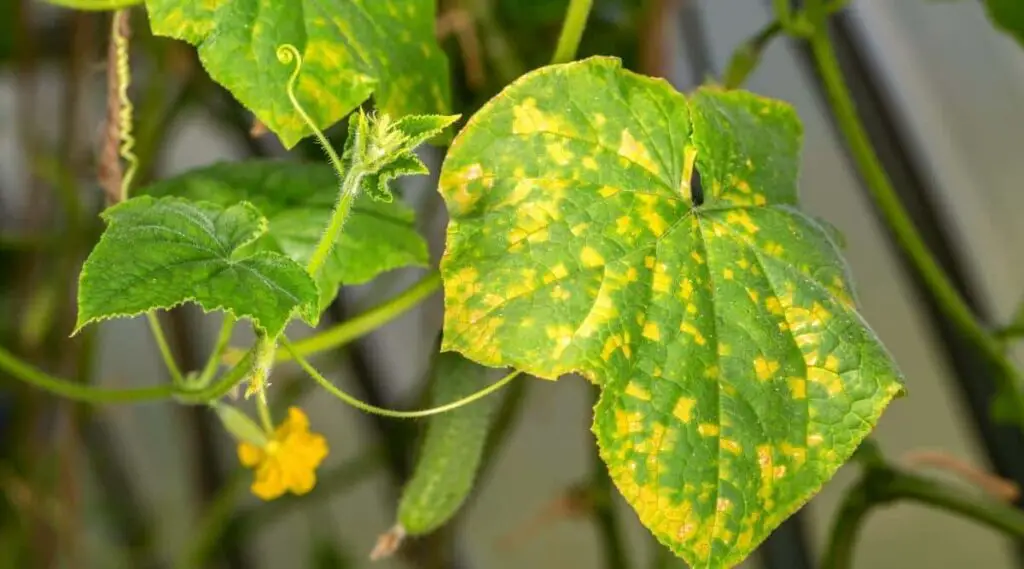
Cucumbers are susceptible to a variety of pests and diseases, which can be detrimental to their growth and overall health in hydroponic gardens. However, with proper preventive measures and effective management strategies, gardeners can minimize the impact of these issues and ensure successful cucumber cultivation.
One common pest that affects cucumber plants is aphids. These small, soft-bodied insects feed on the sap of the plants, causing stunted growth and distorted leaves. To prevent aphid infestations, it is important to regularly inspect the plants for any signs of these pests. Introducing natural predators like ladybugs or lacewings can help control aphid populations. Additionally, sticky traps placed strategically around the garden can trap flying aphids. In cases of severe infestation, organic insecticidal soaps can be used, following the manufacturer’s instructions.
Another common challenge in cucumber cultivation is the occurrence of fungal diseases, such as powdery mildew. This disease appears as a white, powdery coating on the leaves, affecting their ability to photosynthesize and leading to reduced yield. To prevent and manage powdery mildew, ensure proper air circulation and ventilation in the hydroponic system. Avoid overcrowding the plants, as this can create a humid environment conducive to disease development. Regularly remove any infected leaves and dispose of them properly. Applying a mildew-resistant fungicide, following the recommended application rates, can also help control the disease effectively.
Pruning and Training Techniques for Hydroponic Cucumber Plants
Proper pruning and training techniques are essential for maximizing yields and ensuring healthy growth in hydroponic cucumber plants. By implementing these techniques, gardeners can improve air circulation, increase sunlight exposure, and optimize space utilization.
One common pruning method for hydroponic cucumbers is removing lateral shoots, also known as suckers. These are the side branches that emerge from the leaf axils of the main stem. By removing these suckers, gardeners can redirect the plant’s energy towards fruit production rather than unnecessary vegetative growth. It is recommended to remove suckers when they are small and tender, using a sharp pair of scissors or pruning shears to avoid damage to the main stem. However, it is important to note that excessive pruning can lead to reduced yields, so it is crucial to maintain a balance and avoid overpruning.
Training techniques, such as trellising, are also commonly used in hydroponic cucumber cultivation. Trellising involves guiding the vines to grow vertically along a support system, such as a wire or trellis. This not only helps in preventing the cucumber plants from sprawling on the ground but also improves air circulation around the plants, reducing the risk of diseases. Additionally, trellising ensures that the cucumbers hang freely, preventing deformities and providing easier access for harvesting. It is important to regularly adjust and tie the vines to the trellis to keep them properly supported and prevent them from falling or becoming tangled.
Harvesting and Storing Hydroponically Grown Cucumbers
When it comes to harvesting hydroponically grown cucumbers, timing is key. Cucumbers are typically ready to be harvested when they have reached their desired size, firmness, and color. It is important to monitor the growth of the cucumbers closely to ensure that they are harvested at the right time to maximize flavor and quality.
To harvest cucumbers, gently grasp the fruit and twist it off the vine with a slight upward motion. It is crucial to avoid any rough handling or excessive force, as this can damage the delicate fruits. Additionally, using clean and sharp tools such as scissors or pruning shears can help prevent any accidental damage to the plant during harvest.
Once harvested, hydroponically grown cucumbers should be immediately placed in a cool, dry storage area to maintain their freshness. Cucumbers are highly perishable and can deteriorate quickly if not properly stored. Ideally, they should be stored at a temperature of around 50-55°F (10-13°C) with a relative humidity of 90-95%. Wrapping the cucumbers loosely in plastic wrap or placing them in a perforated plastic bag can help maintain their moisture levels and extend their shelf life.
By following proper harvesting techniques and implementing appropriate storage practices, hydroponic cucumber growers can ensure that their hard work pays off with a bountiful harvest of fresh and flavorful cucumbers.
Exploring Different Hydroponic Systems for Cucumber Cultivation
When it comes to exploring different hydroponic systems for cucumber cultivation, there are several options available to consider. Each system has its own unique advantages and disadvantages, so it’s important to choose the one that best fits your specific needs and requirements.
One popular system for growing cucumbers hydroponically is the nutrient film technique (NFT). In this system, a thin film of nutrient-rich water continuously flows over the plant roots, providing them with a constant supply of water and nutrients. This system is known for its efficiency and water-saving capabilities, making it a great choice for those concerned about sustainability and water conservation.
Another option is the deep water culture (DWC) system. In this system, the plant roots are suspended in a nutrient-rich water solution with the help of floating rafts. The roots are fully submerged in the water, allowing for maximum nutrient absorption. This system is relatively simple to set up and maintain, making it ideal for beginners or those with limited space.
Alternatively, the ebb and flow (also known as flood and drain) system is another popular choice for cucumber cultivation. This system involves periodically flooding the plant roots with a nutrient solution and then allowing the excess water to drain away. This cycle is repeated several times a day, providing the plants with ample nutrients and oxygen. The ebb and flow system is versatile and can be easily customized to accommodate different plant sizes and growth stages.
No matter which hydroponic system you choose, it’s important to closely monitor and adjust environmental factors such as pH levels, temperature, and humidity to ensure optimal plant growth. Additionally, regular maintenance and cleaning of the system are crucial to prevent the build-up of algae or other contaminants that can negatively affect plant health. By selecting the right hydroponic system and implementing proper care and maintenance practices, you can set yourself up for successful and bountiful cucumber cultivation.
Tips for Maximizing Yield and Quality in Hydroponic Cucumber Production
Maximizing yield and quality in hydroponic cucumber production requires attention to several key factors. First and foremost, selecting the right cucumber varieties for your hydroponic system is crucial. Look for varieties that are known for their high yield potential and disease resistance. By choosing the right varieties, you can ensure a more successful harvest.
Another important aspect to consider is providing optimal nutrient solutions for your hydroponic cucumber plants. Cucumbers are heavy feeders, so it’s essential to supply them with a balanced blend of nutrients. Regularly monitor and adjust the nutrient levels to maintain an ideal balance, as this will help promote healthy growth and maximize yields.
Creating the ideal hydroponic environment for cucumber growth is also vital. Cucumbers thrive in warm and humid conditions, so maintaining a stable temperature and humidity level is crucial. Ensure proper ventilation and consider using environmental control systems, such as fans or misters, to regulate temperature and humidity.
In addition to these tips, proper pruning and training techniques can also play a significant role in maximizing cucumber yield and quality. Regularly remove any side shoots and tendrils that may divert energy away from fruit production. Training the vines vertically or horizontally can also help optimize space usage and facilitate better light penetration.
By paying attention to these factors and implementing the right strategies, hydroponic cucumber growers can increase their yield and quality, ultimately leading to a more successful and rewarding harvest.
Success Stories: Examples of Successful Hydroponic Cucumber Farmers
Hydroponic cucumber cultivation has gained significant popularity among farmers due to its numerous benefits. Many farmers have embraced this innovative technique and achieved remarkable success in their cucumber production. Let’s take a look at a couple of inspiring success stories that highlight the potential of hydroponic cucumber farming.
One of the success stories comes from John Smith, a farmer based in California. With years of experience in traditional soil farming, Smith decided to venture into hydroponics. He meticulously studied the various aspects of hydroponic cucumber cultivation, including nutrient solutions, environmental control, and pruning techniques. Implementing his knowledge, Smith set up a state-of-the-art hydroponic system and started growing cucumbers. The results were astounding, with consistently high yields and exceptional crop quality. Smith attributes his success to the precise control over nutrient delivery, optimized environmental conditions, and efficient pest management strategies provided by the hydroponic system.
Another inspiring example is Sarah Johnson, an aspiring farmer from New York. Despite limited space, Johnson was determined to grow cucumbers all year round. She turned to hydroponics and converted her small backyard into a thriving hydroponic cucumber garden. Through careful selection of cucumber varieties suitable for hydroponic systems and diligent monitoring of pH levels and temperatures, Johnson achieved impressive results. Her success story serves as a testament to the adaptability and scalability of hydroponic cucumber cultivation, even in urban settings.
These success stories illustrate the potential of hydroponic cucumber farming to transform traditional agricultural practices. By harnessing modern techniques and technologies, farmers like John Smith and Sarah Johnson have not only increased their yields but also maximized the quality and consistency of their cucumber crops. Their achievements encourage aspiring hydroponic farmers to embark on this exciting journey and unlock the vast possibilities of hydroponic cucumber cultivation.
Overcoming Challenges in Hydroponic Cucumber Cultivation
Hydroponic cucumber cultivation offers numerous benefits, including increased yield, reduced water usage, and the ability to control environmental conditions. However, like any farming method, it comes with its own set of challenges. One challenge that hydroponic cucumber growers may face is nutrient imbalance. Proper nutrient solution management is crucial to ensure the plants receive all the essential elements they need to grow and thrive. Regular monitoring and adjusting of nutrient levels, based on plant needs and water quality, can help overcome this challenge.
Another challenge in hydroponic cucumber cultivation is the control of pests and diseases. Since hydroponic systems provide an ideal environment for plant growth, it can also create favorable conditions for pests and diseases to thrive. Preventive measures such as maintaining a clean growing environment, practicing good sanitation, and regularly inspecting plants for any signs of pests or diseases can help mitigate this challenge. Additionally, implementing integrated pest management strategies, such as using beneficial insects or organic pest control methods, can provide effective and sustainable solutions.
Overcoming challenges in hydroponic cucumber cultivation requires careful monitoring, proactive management, and continuous learning. By staying informed about the latest research and innovative techniques, hydroponic cucumber growers can overcome these challenges to achieve successful and sustainable production.
Future Trends and Innovations in Hydroponic Cucumber Farming
As the popularity of hydroponic cultivation continues to rise, so does the development of innovative trends and technologies in the field. When it comes to hydroponic cucumber farming, there are several future trends and innovations that are worth exploring. One such trend is the use of vertical farming systems for cucumber production. By utilizing vertical space, farmers can maximize their crop yield and minimize the use of land. This method allows for greater crop density and efficient use of resources, making it an attractive option for growers looking to optimize their hydroponic cucumber farms.
Another exciting trend in hydroponic cucumber farming is the integration of automation and artificial intelligence (AI) technologies. These advancements have the potential to revolutionize the way cucumbers are grown in controlled environments. AI-powered systems can monitor and adjust essential factors such as nutrient levels, pH balance, temperature, and humidity, ensuring optimal growing conditions for the plants. By automating these processes, growers can achieve consistent and precise results while reducing the need for manual labor. This not only increases efficiency but also allows for better resource management, ultimately leading to higher yields and improved crop quality.
In conclusion, the future of hydroponic cucumber farming is promising, with emerging trends and innovations paving the way for more sustainable and efficient cultivation practices. Vertical farming systems and the integration of automation and AI technologies are just a couple of the exciting advancements on the horizon. By embracing these trends, growers can stay ahead of the curve and reap the benefits of increased productivity, reduced resource consumption, and enhanced crop quality. As the hydroponic industry continues to evolve, it is crucial for growers to stay informed and adapt to the latest advancements to ensure their success in the ever-expanding field of hydroponic cucumber farming.
What are some future trends in hydroponic cucumber farming?
Some future trends in hydroponic cucumber farming include the use of advanced automation and technology, such as AI-driven monitoring systems and robotics, to improve efficiency and productivity. There is also a growing interest in vertical farming and utilizing unused urban spaces for hydroponic cultivation.
How can I prevent and manage common pests and diseases in hydroponic cucumber gardens?
To prevent and manage common pests and diseases in hydroponic cucumber gardens, it is important to maintain strict hygiene practices, regularly monitor plants for signs of infestation or disease, and implement integrated pest management techniques. This may include using biological controls, such as beneficial insects, and employing physical barriers or traps.
What are some pruning and training techniques for hydroponic cucumber plants?
Pruning and training techniques for hydroponic cucumber plants include removing lateral shoots to promote vertical growth and improve air circulation, training the main stem along a trellis or wire support to optimize space utilization, and regularly removing any dead or diseased leaves to prevent the spread of pathogens.
How can I maximize yield and quality in hydroponic cucumber production?
To maximize yield and quality in hydroponic cucumber production, it is essential to provide optimal light levels, nutrient solutions, and environmental conditions. Additionally, regular monitoring and adjustment of pH and nutrient levels, proper spacing of plants, and regular maintenance of the hydroponic system are crucial for achieving optimal results.
Can you provide examples of successful hydroponic cucumber farmers?
While specific names may vary, there are numerous success stories in hydroponic cucumber farming. For instance, Farmer X increased their cucumber yield by 30% through implementing automated nutrient monitoring systems and fine-tuning their nutrient solution. Farmer Y successfully employed vertical farming techniques to cultivate cucumbers in a limited urban space, yielding a high-quality crop.
What are some challenges in hydroponic cucumber cultivation and how can they be overcome?
Some challenges in hydroponic cucumber cultivation include maintaining optimal nutrient levels, preventing and managing pests and diseases, and controlling environmental factors. These challenges can be overcome through regular monitoring, implementing integrated pest management strategies, maintaining proper hygiene, and using advanced technology for efficient control of nutrient solutions, temperature, and humidity.
What are the different hydroponic systems that can be used for cucumber cultivation?
There are several hydroponic systems that can be used for cucumber cultivation, including nutrient film technique (NFT), deep water culture (DWC), vertical hydroponics, and aeroponics. Each system has its advantages and considerations, and the choice depends on factors such as available space, budget, and desired level of automation.
Are there any future innovations expected in hydroponic cucumber farming?
Yes, there are several future innovations expected in hydroponic cucumber farming. These may include the development of new nutrient formulations tailored specifically for cucumber plants, advancements in automation and robotics to further optimize productivity, and the integration of renewable energy sources to reduce the environmental footprint of hydroponic systems.

